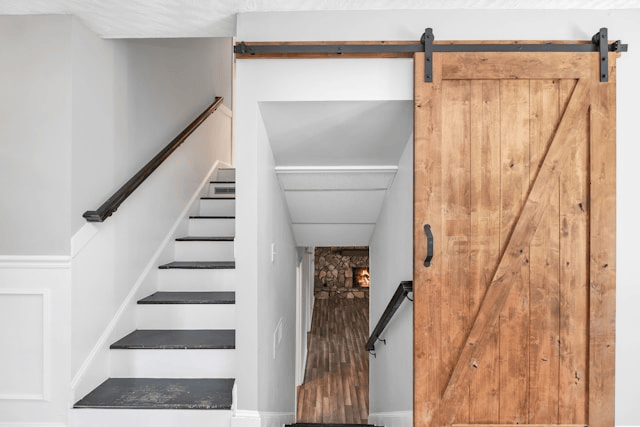Sliding barn doors have become a stylish and functional solution for homeowners looking to add character and save space. Whether you’re upgrading a bedroom entrance, concealing a laundry area, or just looking for a bold interior feature, a barn door installation can make a big impact. The best part? With the right tools and a bit of patience, you can tackle this project yourself.
This sliding barn door guide will walk you through each step of the process from prep to finish so you can confidently complete your DIY barn door install.
Tools and Materials You’ll Need
Before you get started, gather all the tools and materials required to install a sliding barn door:
Tools:
-
Tape measure
-
Level
-
Drill and drill bits
-
Stud finder
-
Socket wrench
-
Screwdriver
-
Pencil or chalk
-
Ladder or step stool
-
Safety glasses
Materials:
-
Sliding barn door
-
Sliding barn door hardware kit (track, rollers, stops, floor guide)
-
Mounting board (if necessary)
-
Screws and wall anchors
-
Handle or pull (optional)
-
Wood filler or caulk (for finishing touches)
Step 1: Measure the Doorway
The first step in how to install a sliding barn door is accurate measurement. Measure the width and height of your door opening. Your door should be slightly wider and taller than the opening to fully cover the space and block light or sound effectively.
Sizing Tips:
-
Width: Add 2–3 inches on each side of the opening to get the proper door width.
-
Height: The door should be at least an inch taller than the opening, depending on your hardware.
If you’re using an existing door slab, ensure it matches your measurement needs. If you’re buying a pre-made barn door, check its specs before ordering.
Step 2: Choose the Right Hardware
Barn door hardware is just as important as the door itself. Choose a sliding barn door hardware kit that fits the style and weight of your door. Most kits include the track, rollers, stoppers, and floor guide.
Make sure to consider:
-
The track length: It should be twice the width of your door so it can fully slide open.
-
The weight rating: Ensure the hardware can support your door’s weight.
-
Style compatibility: Match the finish (black, brass, brushed nickel) with your room decor.
Step 3: Prepare the Mounting Surface
Check your wall to determine how the track will be mounted. If the wall doesn’t have blocking or studs in the right location, install a mounting board (also called a header board) first.
How to install the mounting board:
-
Use a stud finder to locate the wall studs above the doorway.
-
Cut a board (1×4 or 1×6) to match the length of the track.
-
Attach it securely to the studs using lag bolts or wood screws.
-
Paint or stain the board to match your trim or wall color for a finished look.
A solid mounting surface ensures your track won’t rip out of the wall under the weight of the door.
Step 4: Install the Track
Now, it’s time to install the sliding track.
-
Mark the height of the track: Measure from the floor to the top of the door, then add 1–1.5 inches for ground clearance.
-
Level the track: Use a long level to ensure your line is perfectly straight.
-
Drill pilot holes into your mounting board or wall studs.
-
Attach the track using the hardware provided in the kit.
Pro Tip: Have a helper hold the track while you secure it in place it can be long and awkward to manage alone.
Step 5: Attach Hardware to the Door
With the track in place, you’ll now install the rollers or hangers to the top of the door.
-
Lay the door flat on a pair of sawhorses or a padded surface.
-
Measure and mark where the rollers should be attached (usually around 2 inches in from each edge).
-
Drill pilot holes, then secure the hangers with the provided bolts.
Double-check that both rollers are aligned and level to prevent the door from hanging unevenly.
Step 6: Hang the Door
With your rollers securely attached, it’s time to hang the door on the track.
-
Carefully lift the door and align the rollers with the track.
-
Set the door onto the track and slide it back and forth to ensure smooth operation.
This is where your barn door installation really comes to life!
Step 7: Add Stoppers and Floor Guide
To finish your DIY barn door install, add the final pieces for safety and smooth operation.
Install Door Stops
These prevent the door from rolling off the track. Most kits include stoppers that can be adjusted and tightened into place at either end of the track.
Install the Floor Guide
Floor guides keep the door aligned and prevent swinging. There are several types:
-
T-slot (requires a groove in the bottom of the door)
-
Wall-mounted
-
U-shaped floor-mounted
Choose the one that suits your flooring and door style.
Optional: For a high-end touch, consider adding a soft-close mechanism that gently slows the door as it reaches the end of the track.
Troubleshooting Tips
-
Track isn’t level? Adjust your mounting board or reposition the track using a level.
-
Door won’t slide smoothly? Check for debris on the track and ensure rollers are tightened evenly.
-
No studs? Use high-strength wall anchors or toggle bolts, or opt for a solid mounting board.
-
Gap between door and wall? Use a thicker mounting board to bring the door closer to the opening.
Final Touches and Style Tips
Now that your sliding barn door is installed, finish it off with personal style:
-
Add a handle or pull: Choose one that matches your home’s decor industrial, farmhouse, or minimalist.
-
Paint or stain the door: Match your trim, or go bold with contrast color.
-
Style the surrounding area: Consider trim molding or barn door lighting for extra impact.
Sliding barn doors aren’t just functional they’re focal points.
Safety Tips to Keep in Mind
-
Always wear eye protection when drilling.
-
Don’t attempt to hang a heavy door by yourself get a helper.
-
Use proper anchors for drywall if studs aren’t available.
-
Check all hardware is tight and secure before using the door.
Conclusion
Installing a sliding barn door is a great way to add charm and function to any room. With a bit of planning and the right tools, your barn door installation can be a rewarding DIY project that transforms your space.









